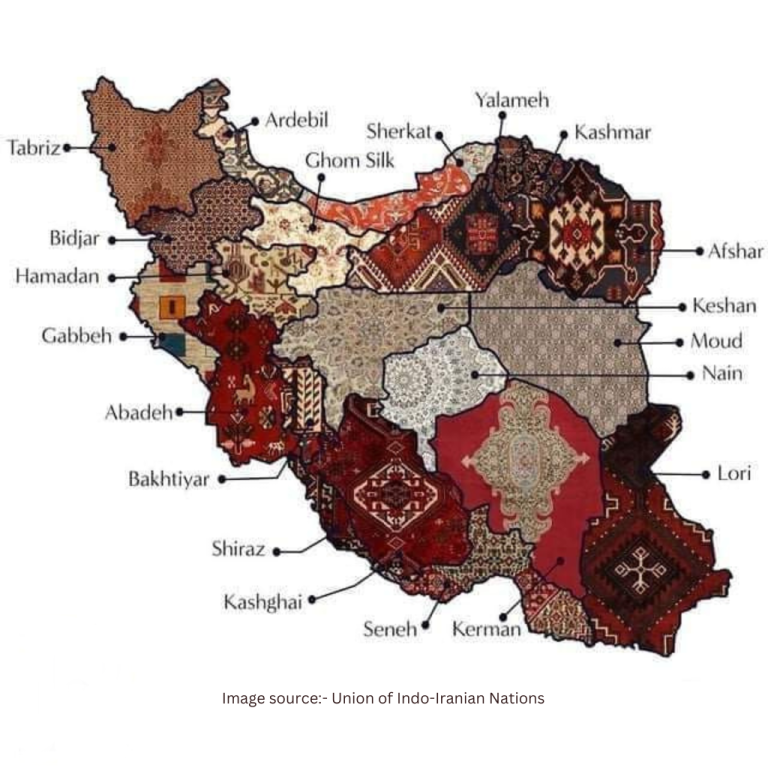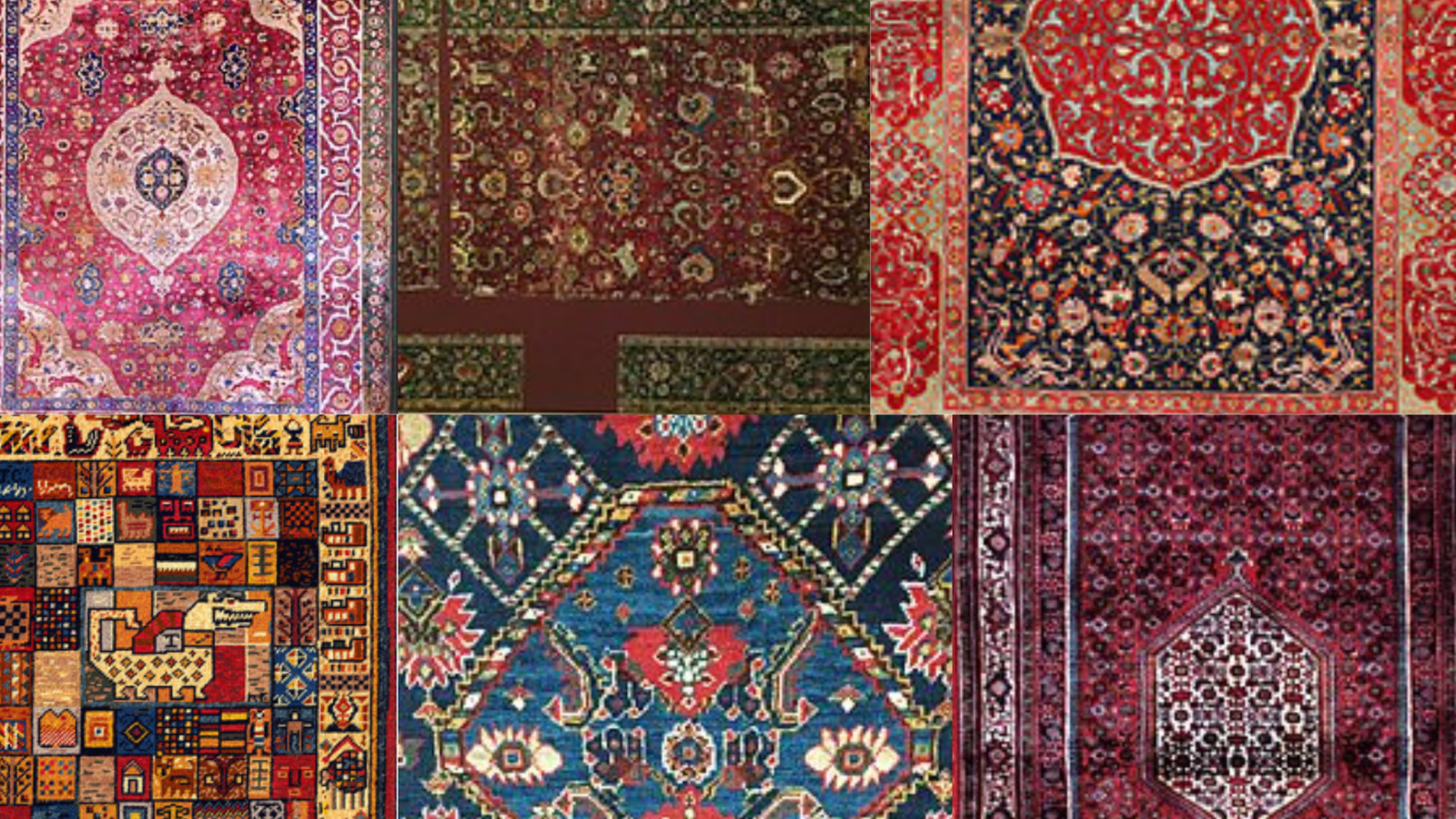Persian rugs are a quintessential part of Persian culture and art, known for their intricate designs, superb craftsmanship, and deep cultural significance. These rugs are traditionally handwoven in Iran, formerly known as Persia, which is where they derive their name.
The tradition of weaving Persian rugs stretches back thousands of years, originally a craft practiced by shepherds and nomads. Over the centuries, through various invasions and cultural exchanges, Persian rug designs have transcended their regional origins to be appreciated and produced globally.
Before we go any further, it’s important to understand the types of Persian rugs that are categorized based on the diverse regions of Iran. Each region contributes its unique motifs, color schemes, and patterns, adding rich variety to the array of Persian rugs available.

What Are Persian Rugs?
A Persian rug, also referred to as an Iranian carpet, is a dense textile crafted for both practical and symbolic functions, originating from Iran, historically known as Persia. Among the array of Oriental rugs produced within the “rug belt” region, Persian carpets distinguish themselves through their diverse and intricate designs.
Persian rugs are crafted by artisans through hand-weaving or hand-knotting techniques in Iran. While the hand-knotted variety enjoys widespread popularity worldwide, the handwoven types, known as Kilims, also boast remarkable beauty and craftsmanship.
Persian rugs typically fall into three main categories: city, village, and tribal. These categories derive their names from the cities, villages, or tribes ( Tabriz, Kerman, Ravar, Neyshabour, Mashhad, Kashan, Isfahan, Nain, and Qom ) where they were created, reflecting distinct styles and traditions.
How Are Persian Rugs Made?
Persian rugs are renowned for their intricate designs, rich colors, and high quality. The process of making these rugs is highly skilled and often involves traditional techniques passed down through generations. Here are the steps involved in the Persian rug weaving process:
- Material Selection
Persian rugs are typically made from wool, silk, and cotton. The quality of the material significantly influences the final product. Wool stands as one of the most ancient choices for crafting various types of Persian rugs, prized for its superior quality sourced from the elevated regions of Iran.
Following closely behind the durable and soft handspun wool rugs are cotton rugs, which remain highly favored for their comfort, longevity, and ease of obtaining the material.
Conversely, silk stands out as a premium material, leading to a limited production of rugs crafted from it. Furthermore, silk frequently gets blended with other fabrics to enhance the intricacy of designs and the texture, resulting in even more exquisite detailing.
- Carding and Spinning
The wool or silk fibers are carded to align them in the same direction and remove any impurities. Then, the fibers are spun into yarns using spinning wheels or machines. This step is crucial as it determines the strength and consistency of the yarn.
Dyeing
The yarns are dyed using natural or synthetic dyes. Traditional Persian rugs often use natural dyes derived from plants, insects, or minerals, which produce rich and long-lasting colors. The dyeing process may involve multiple stages to achieve the desired hues and shades.
- Designing
Skilled artisans create the rug’s design either by drawing it directly onto the warp threads or by following a predetermined pattern. Medallion designs, vibrant colors, and intricate patterns collectively serve as iconic symbols distinguishing genuine and time-honored Persian rugs.
Persian rug patterns encompass a rich tapestry of imagery, ranging from religious motifs to depictions of daily life and historical monuments. Among the myriad designs, some classics stand out, such as the Paradise Garden, Life Tree motifs, and representations of flora like pomegranates, cypresses, and weeping willows.
Delving into the symbolism embedded in these patterns unveils profound narratives reflecting the weavers’ lives. Experts skilled in deciphering Persian rug styles can discern not just aesthetic beauty but also the cultural and geographical origins of each piece. This intricate interplay of symbols and stories transforms each rug into a vibrant chronicle of tradition and craftsmanship.
- Knotting and Weaving
The weaving process begins by tying knots of dyed yarn around pairs of warp threads. The two main types of knots used in Persian rugs are the asymmetrical (Persian) knot and the symmetrical (Turkish) knot. Each knot is individually tied by hand, with precision and attention to detail.
Using a combination of knots and weft threads, the weaver gradually builds the rug’s pile, row by row.
- Finishing
Once the weaving is complete, the rug undergoes several finishing processes. These may include shearing to trim the pile to a uniform height, washing to remove any excess dye or impurities, and stretching to ensure the rug lies flat and retains its shape, etc
The entire process of making a Persian rug is labor-intensive and can take anywhere from several months to several years to complete, depending on the size, complexity, and quality of the rug. The result is a masterpiece of craftsmanship that reflects centuries of tradition and cultural heritage
Types Of Persian Rugs
Persian carpets are beloved worldwide for a multitude of reasons. In bygone eras, these exquisite creations held esteemed status, often bestowed as prestigious gifts. Royals revered them as prayer mats, tokens for esteemed delegates, and symbols of tribal loyalty. Each antique rug was uniquely crafted, boasting unmatched designs—a rarity not found in today’s mass-produced rugs.
Types of Persian carpets typically fall into three main categories: city, village, and tribal. These classifications derive their names from the cities, villages, or tribes where they originate.
City rugs are renowned for their exceptional quality. Crafted by skilled artisans known as “master weavers,” these rugs are often considered works of art. Some master weavers even sign their creations, adding a personal touch to each piece. Primarily a profession for men, weaving city rugs is a full-time career and primary source of income for these artisans.
On the other hand, village and tribal rugs are produced within families or communities. Weavers in villages or nomadic tribes create these rugs, drawing inspiration from their surroundings or cultural heritage. Often crafted from memory or influenced by the weavers’ travels, these rugs serve as an additional source of income for the families involved. While they may not reach the same level of intricacy and refinement as city rugs, village and tribal rugs possess a distinct charm and authenticity, reflecting the traditions and lifestyles of their creators.
Let’s see how many types of Persian carpets are there below:
Pazyryk Rugs
The Pazyryk carpet is one of the oldest known carpets in the world, dating back to the 5th century BCE. It was discovered in the 1940s in the Pazyryk Valley of the Altai Mountains in Siberia, Russia, in the tomb of a Scythian nobleman.
Bhaktiari Rugs
The Bakhtiari carpet, also spelled Bhaktiari, is a type of Persian rug originating from the Bakhtiari tribe, which resides in the Zagros Mountains of Iran. These rugs are renowned for their durability, intricate designs, and vibrant colors. These carpets often feature bold geometric patterns, stylized floral motifs, and intricate medallions. The designs are typically inspired by the natural surroundings of the Bakhtiari region, such as flowers, trees, and animals.
Bakshayesh Rugs
Bakshaish, also spelled Bakshayesh, is situated in modern-day Azerbaijan within Persia and stands as the oldest village of rug weavers in the country. These Persian rugs are not only highly artistic but also depict imagery reflecting traditional tribal livelihoods and classical Iranian designs.
Alternatively referred to as Bakshish, these rugs typically boast larger dimensions compared to those from other regions. Moreover, their designs often highlight central folklore characters in smaller scales alongside rustic, asymmetrical motifs.
In terms of color palette, Bakshaish rugs commonly feature neutral tones like ivory, white, and beige, as well as subdued warm tones and metallic hues. These varied color choices contribute to the rugs’ timeless appeal and versatility in complementing diverse interior styles.
Bijar Rugs
Bijar rugs trace their origins to a bustling market center nestled in Northwestern Iran, situated approximately 150 miles south of Tabriz. These rugs, featuring a traditional Turkish knot, bear a striking resemblance to Kurdish carpets, distinguished by their dense pile.
The name Bidjar is synonymous with durability and strength in the eyes of numerous rug connoisseurs. These rugs are renowned for their robustness, compactness, and exceptional durability. Weavers employ a hefty comb crafted from wood and metal to vigorously beat the weft and knots, resulting in a pile that nearly stands upright. Consequently, the pile is tightly woven, offering minimal permeability. This distinctive weaving technique and superior quality have earned Bidjar rugs the moniker “the king of carpets”.
Esfahan Rugs
From 1598 to 1722, Isfahan also spelled Esfahan, served as the capital of Persia. This city, adorned with Safavid-era Islamic architecture dating back to the 16th century, is now designated as a UNESCO World Heritage site.
The design of Esfahan Persian rugs are frequently inspired by the tilework found in mosques and the gardens of palaces, predominantly featuring floral motifs. They boast a high knot count, contributing to their esteemed status as some of the finest and highest quality rugs in the country.
Isfahani weavers are renowned for their meticulous attention to achieving technical excellence. As a result, they consistently produce carpets of exceptional quality, characterized by precise knot counts and impeccable symmetry.
Farahan Rugs
The Farahan Persian rugs, originating from the Farahan district located in west-central Iran, is renowned for their exquisite craftsmanship and detailed designs.
The production of Farahan rugs peaked during the 19th and early 20th centuries when Persian carpet weaving underwent a significant revival. The region’s weavers adapted traditional styles to the tastes of the Western market while maintaining high standards of quality and design. Today, antique Farahan rugs are considered valuable artifacts that represent the rich cultural heritage of Persian rug-making.
Today’s Farahan rugs are known for their unique color nuances and detailed designs, qualities that have proven impossible to replicate. This distinction is due in part to the fascinating history behind the naturally dyed hues used in older Farahan carpets.
These rugs are highly valued for their sophisticated geometric designs and color palette, particularly for their variations of the classic Herati pattern. This iconic design consists of a central floral motif from which infinite bending leaves radiate, creating a sense of endless intricacy and flow
Gabbeh Rugs
The term “Gabbeh” or “Gabba” comes from the Persian, meaning raw, natural, uncut.” Gabbeh rugs are hand-woven, medium-sized pile rugs known for their coarse quality and abstract designs. These rugs are distinguished by their expansive fields of color and a playful approach to geometric patterns. Gabbehs are particularly popular among the populations of the Zagros Mountains in Iran, including the Kurdish, Luri, and Qashqai communities. Typically, these rugs are crafted by women, reflecting their artistic expression and cultural significance.
These rugs feature simple, rudimentary patterns that typically include a limited number of decorative elements, most often rectangular shapes that resemble animals. These rugs are known for their use of bright colors like yellow and red. While Gabbeh designs often incorporate large, solid fields of color, the hues are variegated, creating a dynamic appearance with zones of varying shades across the rug.
Heriz/Serapi Rugs
Heriz and Serapi rugs are known for their durability and high-quality wool. The prominent, geometric central medallion of Heriz rugs makes them easily recognizable. Typically, products from the Heriz region are larger, with smaller scatter rugs being quite rare.
The traditional Heriz features a distinctly rectilinear medallion design, which has remained relatively unchanged over the years. These rugs often exhibit less pattern repetition, feature a thick pile, and are distinguished by a robust double selvage along the edges.
Kashan/Mohtashan Rugs
The distinctive central medallion design and the rich palette of red, blue, and beige hues set Kashan carpets apart. Their costliness is attributed to the traditional Persian style, the dense knotting, and the use of high-quality wool. Furthermore, Kashan carpets have a direct lineage to the Golden Period of Persian Weaving, which flourished under Shah Abbas.
Kerman Rugs
Kerman, situated in south-central Iran, encompasses both a city and a province. The manufacturing of Kerman rugs typically involves using an asymmetrical knot on a cotton foundation.
The Damask Rose motif reigns as the most favored design element in Kerman rugs, particularly prominent in styles like “Sabzikar Ravar” and “Gol Sorkhi” (Red Rose) rugs. Additionally, Kerman rugs feature a myriad of other renowned motifs including “Ghab Ghora’ani,” “Setooni,” “Ghabi,” “Kheshti,” “Saraam Atiyeh,” “Jangali,” “Shekargah,” “Lachak-Toranj and antique vases.” Antique Kerman carpets often showcase the Toranj motif along borders and narrow lines.
Contemporary Kerman rugs tailored for Western markets often showcase a palette of soft pastel hues like amber, pink, and blue-gray. These rugs may incorporate Western-inspired patterns such as stripes and repetitive motifs, alongside traditional elements like vase and garden themes, animal shapes, and pictorial designs.
Khorassan/Mashad Rugs
Khorasan city carpets are crafted with a cotton base and wool pile, employing the Persian Jufti knot technique since the sixteenth century. This method accelerates weaving by utilizing four warp threads, doubling the speed compared to the traditional two-thread knotting process.
Mashad carpets are celebrated for their intricate designs, often depicting lush gardens and shrubbery. Meanwhile, Herat carpets are distinguished by the Herati design, featuring stylized motifs of leaves and flowers. Safavid-era variations of these carpets are esteemed for their depiction of palmettes, Chahar Bagh (four-garden layout), cypress trees, lattice patterns, and shrub motifs.
Khotan Rugs
East Turkestan’s Khotan, now part of Western China’s Xinjiang Province, held a distinguished status as an ancient center for rug craftsmanship. It was among the first regions outside of China to cultivate silk, flourishing as a pivotal stop along the Silk Road for millennia. As a cultural crossroads, Khotan developed its own intricately detailed rug style by the 18th and 19th centuries.
Antique Khotan rugs rank among the most abundant and exquisite specimens available. In contrast to other carpets from East Turkestan, those originating from Khotan possess a notably more international flair.
Khotan rugs adeptly fuse Chinese and Persian design motifs, creating a unique hybrid style influenced by their strategic proximity to both regions. Consequently, Khotan carpets boast vibrant, mixed hues and a harmonious interplay of contrasting elements. Crafted from either wool or silk, these rugs feature asymmetrical knots and are typically long and slender, characterized by a distinctive lustrous sheen.
Older Khotan rugs often showcase grand medallions, intricate borders, and motifs such as pomegranates, reflecting the region’s rich cultural heritage and artistic ingenuity.
Malayer Rugs
Antique rugs hailing from the Malayer region epitomize an angular northwest style known for its diverse array of designs and colors.
These carpets boast a captivating assortment of traditional motifs, ranging from lozenge-shaped medallions to intricate allover patterns, all elegantly showcased against chic monochromatic backgrounds.
Malayer Persian rugs often feature authentic Herati designs and are typically crafted on cotton foundations. While their sizes may vary, most rugs exhibit small to medium dimensions, adorned with nomadic patterns and vibrant red hues as their primary color palette.
The quality of Malayer rugs can vary significantly, influenced by factors such as the intricacy of the pattern, the quality of wool used, the age of the rug, and the knot count.
Sarouk Rugs
Another exceptional choice in the Persian rug realm is Sarouk carpets. Originating from Iran, Sarouk Persian rugs stand out with their distinct Iranian heritage, boasting a cotton foundation and striking, harmonious hues.
Renowned for their top-notch quality, Sarouk carpets are distinguished by their exclusive use of cotton, rather than wool, as the primary material. This distinctive feature contributes to their light texture, accentuated by a blue weft and cotton base, rendering them challenging to replicate.
Characterized by a deep pile and light coloration, Sarouk rugs provide a cozy yet sophisticated touch to any space, with a smooth exterior that invites relaxation and warmth.
Senneh Rugs
Senneh Persian rugs shine with their captivating geometric patterns. Renowned for their rich hues of deep crimson, navy, and brown, these carpets are meticulously crafted in the mountainous regions of Kurdistan province in northwest Iran.
Fashioned from fine wool yarn, the pile of Senneh carpets boasts intricate detailing, while the warp and weft are fashioned from sturdy yet less intricate cotton. This combination results in rugs that are not only visually striking but also durable enough for everyday use.
Sultanabad/Mahal Rugs
Sultanabad Persian rugs from the 19th and early 20th centuries have risen to prominence as prized Persian town weavings, captivating collectors and interior designers alike with their timeless appeal.
These coveted rugs attract two key buyer demographics with their remarkable blend of simplicity and startlingly modern designs, coupled with an elegant, often whimsical, and highly ornate aesthetic. As a result, top-tier vintage Sultanabad rugs have become exceedingly rare finds in today’s global market.
The finest examples of ancient Sultanabad carpets boast expansive and exceptionally distinctive variations of traditional Persian allover designs such as the Herati, the Mina Khani, and the Harshang. These designs are often rendered in soft, radiant pastels and earth tones, further enhancing their allure and appeal.
Tabriz Rugs
Tabriz rugs, originating from one of the earliest rug-weaving regions, are distinguished by their tightly packed knots and low pile. These rugs boast a plethora of intricate patterns, ranging from elaborate curvilinear motifs to depictions of lush gardens adorned with diverse floral themes, captivating hunting scenes, and an array of medallions in various sizes and shapes.
Lori Rugs
Lori Persian rugs, named after the region of Loristan in western Iran where they originate, are renowned for their exceptional quality. Hand-knotted with care, these carpets often feature vibrant designs blending floral and geometric motifs.
Crafted using time-honored techniques handed down through generations, the weaving of Lori rugs is a labor of tradition and skill. Notably, Lori rugs are flat-woven textiles, devoid of the characteristic pile found in other rug styles. This flat-weave construction is achieved through a method that eschews knots, resulting in a unique and enduring textile
How To Identify Persian Rugs?
Identifying a Persian rug involves examining several key characteristics:
- Material
Traditional Persian rugs are handwoven using high-quality materials such as wool, silk, or a combination of both. Look for fine, tightly woven fibers that feel soft and luxurious.
Design and Patterns
Persian rugs often feature intricate designs and patterns inspired by nature, geometric shapes, or historical motifs. Traditional designs include medallions, floral motifs, and intricate borders. These designs are usually symmetrical and meticulously crafted.
- Colors
Persian rugs typically feature rich, vibrant colors that are derived from natural dyes. Look for colors that are deep and saturated, with subtle variations and shading. Traditional color palettes include red, blue, gold, and ivory.
- Knot Density
Higher knot density generally indicates a higher quality rug. Flip the rug over and inspect the back to see if the knots are tightly packed together. A higher knot count often results in finer details and a more durable rug.
FAQs
What materials are Persian rugs made from?
Persian rugs predominantly utilize materials like wool, cotton, and silk. Crafted through a distinctive and time-honored weaving method, these rugs involve meticulous manual knotting, ensuring unparalleled precision in their creation.
Are Persian rugs expensive?
Persian rugs command high prices due to several factors, including the utilization of top-tier materials like wool and silk, intricate and balanced designs, meticulous weaving techniques, the use of natural dyes, and other quality-oriented aspects.
How to clean Persian rugs?
To care for a Persian rug, it’s important to vacuum it regularly to remove dirt and debris. Also, dampen a sponge with a gentle solution of mild detergent and water, then use it to gently scrub works. Once scrubbed, rinse the rug thoroughly under cold water and ensure it’s properly air-dried.
How can I identify a genuine Persian rug?
Genuine Persian rugs are typically hand-woven, which means they may have slight irregularities in their weave or design. If the outer fringes of a Persian rug are sewn, likely, that the rug is not authentic. Genuine Persian rugs typically do not have sewn outer fringes


 Cart is empty
Cart is empty 